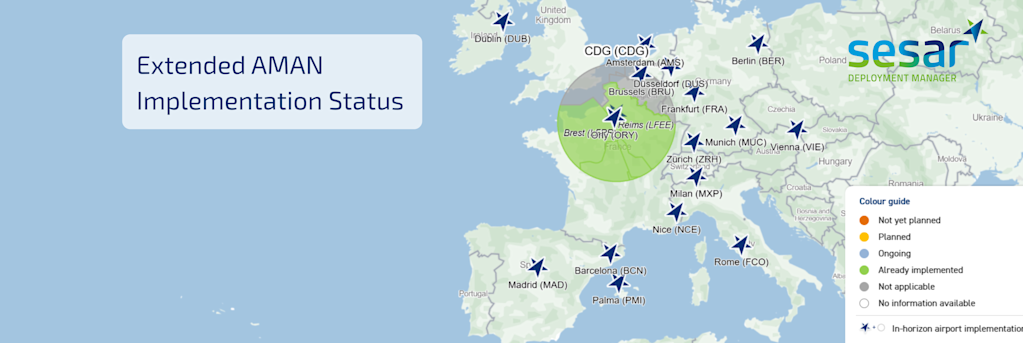

SESAR Deployment Manager launches Extended AMAN interactive map
The new dynamic website feature allows users to navigate through the latest implementation status of E-AMAN in Europe’s busiest airports
SESAR Deployment Manager has developed a resourceful and interactive software tool that contributes to a more engaging visualisation of the deployment evolution of SESAR solutions.
The principal purpose of the Extended Arrival Management functionality (Extended AMAN) —the first of six air traffic management functionalities comprising the SESAR Deployment Programme— is to synchronise the arrival sequence to each mandated airport so that the need for holding is eliminated or at least reduced. To that end, each mandated airport operates a dedicated tool (Arrival Manager - AMAN) calculating the most optimum sequence for each given set of entry conditions, and Extended AMAN ensures that the resulting measures can be implemented on flights at an enlarged horizon, often spanning several upstream Area Control Centres (ACC's). Rather than arriving at a congested merging point uncoordinated and being cleared to a hold to wait, the flights modify their cruise speeds and descent profiles beforehand and arrive at each merging point in their predetermined order and time, resulting in a smooth and efficient flow of arriving traffic all the way to the runway.
The Common Project One regulation, established by the European Commission to steer Air Traffic Management modernisation in Europe, requires E-AMAN (Arrival Management Extended to En-route Airspace) to be implemented within 180 nautical miles, equivalent to 333 km or 45 minutes of flight time approximately, of European Union’s 20 busiest airports. As of 2025, System-Wide Information Management (SWIM) should be implemented to construct the technical interface between the AMAN tool (the system computing the optimised sequence) and the upstream Area Control Centre System receiving the advisories to delay or speed up concerned flights. The map depicts the status of the implementation regardless of the underlying technical means, as it was known following the closure of the 2024 monitoring cycle.
According to the SESAR Deployment Programme Monitoring View 2024, seven out of the twenty mandated airports have implemented the regulatory objective, with the remaining thirteen in various stages of planned or partial implementations; the Deployment Manager recommends to prioritize the implementation in upstream Area Control Centres on the basis of their traffic loading, with the most impactful ACCs to be implemented first. A future update of the map will show the traffic share and associated benefits; the next monitoring cycle applicable for the year 2025 will launch in October 2025 and the map will reflect its outcomes in Q1 2026.
Most mandated airports will have one or more ACC segments declared in the map as Not Applicable and depicted in grey. This comes as a result of an assessment exercise conducted by the Deployment Manager in 2024 and subsequently detailed in the 2024 edition of the SESAR Deployment Programme in accordance with the Regulation text.